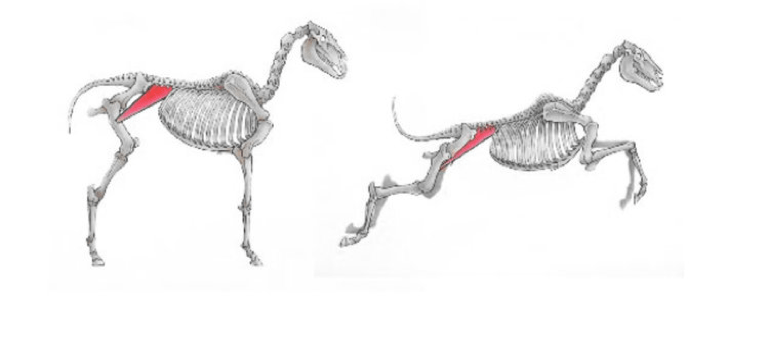The iliopsoas is one of the main hip flexor muscles in a dog. The hip flexors are a group of muscles that attach to your dog’s thigh and are key players in moving the rear limb forward. They also work to as a ‘brake’ to stop the rear limb (and low back) from over-extending during a gallop and explosive movements. The iliopsoas can become injured by a primary strain/tear, or secondary to a low back, hip, or knee issue. Regular stretches can help keep your dog’s iliopsoas loose and help to prevent injuries. This article will look at how to stretch your dog’s iliopsoas (hip flexors).
* This article is meant for healthy dogs. If your dog has any lameness or is diagnosed with a musculoskeletal condition, please talk to your vet or rehab professional prior to starting any new exercises or stretches.
The Iliopsoas
The iliopsoas is a hip flexor. It is a collection of two main muscles, the psoas, and iliacus. These muscles originate from the front of the lower back (psoas) and pelvis (iliacus) and attach via a common tendon to the top of the thigh (iliopsoas).

Stretching the iliopsoas requires the hip joint to be extended so that your dog’s rear leg is stretched out behind them (like the picture above on the right). It can be performed actively or passively.
Stretching the Iliopsoas
Active Hip Flexor Stretch – Front Feet Up Exercise
An active hip flexor stretch is when your dog is actively participating in the stretch. For example, when your dog places their front feet up on your lap for cuddles, they’re actively stretching their hip flexors.
- To stretch the iliopsoas your dog’s front legs need to be higher than their back legs
- Their front legs need to be on a stable platform / elevated surface – small dogs may only need their front feet on a book, while larger dogs it may be a step or chair.
- The surfaces should be non-slip
- Use a lure to encourage your dog to reach a little and stretch their hip flexors (lure them 1-2 inches following the angle of their spine)
- Hold the position for 5 seconds (beginner) to 30 seconds (more advanced)
- Allow them to “break” out of the stretch (have a rest, walk it off) then reset and repeat 3-5 times.
If your dog keeps jumping up on the platform, use your body and lure hand (like I have in the video) to slow them down and direct them / block them from jumping up. It may take a few times. If you don’t get it right, reset and start again. Don’t try to get them to back off the platform.
If your elevated surface is too high, or your lure is incorrect, you may be unwittingly encouraging extension through your dog’s back. It will look like a banana from the side – take a video to check your dog’s technique. We want a neutral spine position through the stretch – for most dogs, this will look like a straight line.
Passive Hip Flexor Stretch
A passive stretch is when you move your dog’s leg to create a stretch (they are relaxed). You perform the stretch on one leg at a time. There are two ways to perform a passive hip flexor stretch and it comes down to your dog’s position. Your dog can be 1. standing or 2. side-lying.
The passive stretches require you to truly understand your dog. There has to be a level of trust and consent from your dog. Your dog also needs healthy hips, as hip extension is the movement that your dog will like least if they have any undiagnosed hip issues.
If you get any resistance from your dog, stop. This may be the first indication that your dog’s hips aren’t as healthy as they once were. Let your vet or rehab professional give the all-clear before continuing to work on the passive hip flexor stretch.
- Standing Passive Hip Flexor Stretch
- Side-lying Passive Hip Flexor Stretch
Conclusion
Hip flexor stretches are an excellent exercise to perform with your healthy dog. They keep your dog’s iliopsoas healthy and give the hip joint a good stretch into extension. The active hip flexor stretch or front feet up exercise also forms an integral part of most rear limb rehabilitation programs. Talk to your vet or rehab professional to see if it’s a good exercise for your dog.
If you want more information on iliopsoas strain in dogs, click here.

